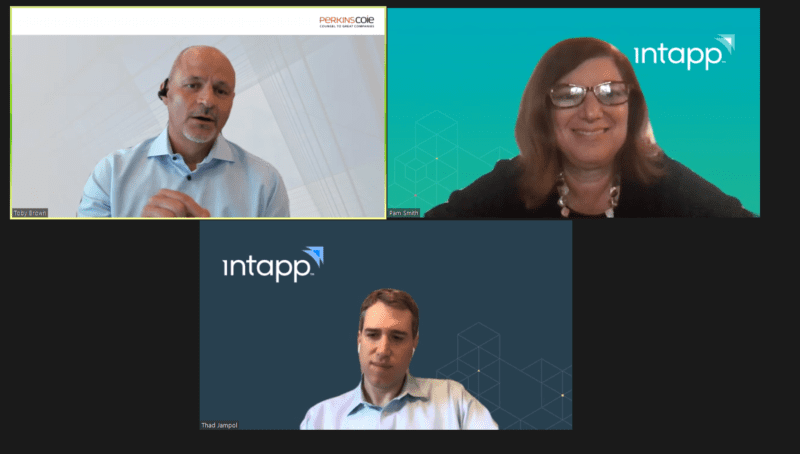In a recent webinar, Intapp welcomed Toby Brown, Chief Practice Management Officer at Perkins Coie, for a lively chat with Thad Jampol, Co-Founder and Chief Product Officer, and Pam Smith, Senior Vice President of Strategic Marketing, discussing how business-value forecasting transforms operational agility and organizational accountability.

The conversation started with a discussion of how law firms typically haven’t relied on forecasting as a core business-planning tool. Forecasting is notoriously hard to get right, and nobody wants to be blamed for getting it wrong. Many firm leaders conflate budgeting and forecasting, bypassing the deep dive that’s required to build sound, well-reasoned predictions for precisely when, where, and how revenue will flow into the firm.
With all of the ambiguities swirling around pandemic-era business planning, firm leadership teams are looking to bolster certainty on all fronts. As a result, one silver lining of COVID-19 may be at least a temporary pause on forecasting resistance. The window is wide-open for a bold embrace of forecasting innovation — powered by industry-specific technology — as a key driver of operational agility and competitive advantage as firms move through a turbulent business cycle.
Defining Business-Value Forecasting
To understand the concept of business-value forecasting, start by distinguishing its two key components: forecasting data and firm pipeline. Whereas forecasting data tells you — at a macro level — what the anticipated revenue stream will look like based on historical performance, the pipeline shows you where your firm sits in the here and now.
“If you’re only looking at forecasting data that’s based on historical performance, you’re essentially looking backwards,” said Brown. “The pipeline should not only drive the forecast, but also capture the specific sources of projected revenue, the timeline for realization, and the parties responsible for delivering the outcomes.”
Implementing Better Forecasting Protocols
Firms report three key challenges with respect to forecasting: unpredictability, internal resistance, and the difficulty of producing a forecast with confidence. Across industries, forecasting creates a pillar of predictability — a backdrop against which your firm can build strategies for resourcing projects and measuring success. Distorted firm forecasts artificially create higher working capital requirements, and overly-buffered and disjointed budgets residing across practice groups hinder the strategic adjustments needed to capitalize on unexpected opportunities. Although there will always be some unknowns, firms can start with reasonable assumptions.
“Some matters are easy to predict. For instance, it’s safe to assume that Walmart will have a certain number of slip-and-fall cases, which you can bake into your forecasting assumptions,” said Brown. “Some clients might have an M&A growth strategy, which means that you can estimate the number of patents and the associated revenue per patent to get to a reasonable proxy. The point here is to focus on what you can confidently predict to build the foundation for your forecasting.”
Overcoming Silos and Hedging
Many law firms struggle with silos with respect to both data and practice groups; this presents a significant roadblock to firmwide transparency with respect to forecasting. Brown and his team address this issue by building two forecasts — based on key clients and top practice groups — because these specific views of business-value forecasting have proven to be enlightening, valuable, and actionable for firm leadership teams.
“Lawyers live and die by their reputations. When they’re on the hook to hit a number, their reputation is at stake, and — because no lawyer is satisfied with a passing grade — they feel compelled to go above and beyond,” said Brown. “Exceeding the forecast is obviously a good thing, but not expected; eyebrows shoot up when a lawyer goes over the top multiple quarters in a row, because it indicates hedging. And, when lawyers hedge to cover themselves, we never have a true picture of our projected revenue stream, which impedes business planning.”

Putting the Pieces in Place for Business-Value Forecasting
It all starts with recognizing that you need a forecast that budgets on the go-forward at the partner and practice area level; and — at a minimum — the forecast should be revisited quarterly, but ideally in real time and on demand. Implementing technology that captures and analyzes pricing data and firm experience — like Intapp Pricing and Intapp Experience — can significantly improve the efficacy of your forecasting approach and ongoing process.
The solution you choose should provide easy and centralized access to data firmwide, and require minimal manual processes to encourage adoption. Incorporating AI and machine learning means that your solution gets smarter from experience, and adjusts to new inputs to perform human-like tasks better. “We view Intapp as a valued contributor — not just a service provider — in our forecasting,” said Brown. “Because the Intapp folks live and breathe forecasting for law firms, they are able to provide an unparalleled level of expertise and technology to help firms get to where they need to be to realize the benefits of business value forecasting.”
To learn more about implementing business-value forecasting at your firm, register to watch the webinar replay on demand.
For a deeper dive into the polls taken from this webinar, read this blog post.